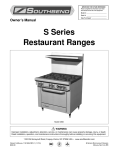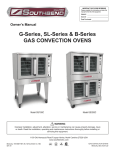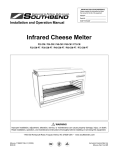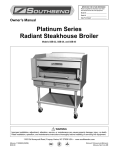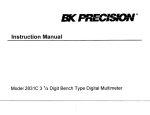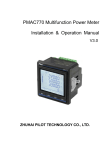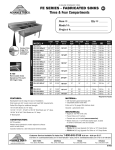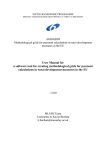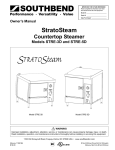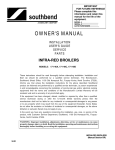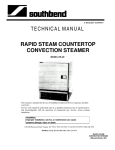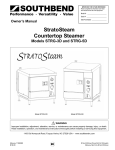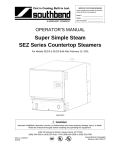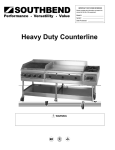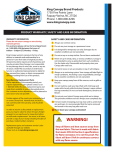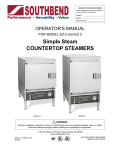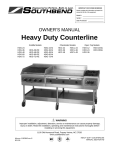Download Wendy`s Electric Range
Transcript
IMPORTANT FOR FUTURE REFERENCE Please complete this information and retain this manual for the life of the equipment: Range-Top Model #: __________________ Range-Top Serial #: __________________ Oven-Base Model #: __________________ Oven-Base Serial #: __________________ Date Purchased: ____________________ OWNER’S MANUAL Wendy’s Electric Range Range-Top Model SE36N-TTT, Oven-Base Model TVES/10WC WARNING Improper installation, adjustment, alteration, service or maintenance can cause property damage, injury or death. Read the installation, operating and maintenance instructions thoroughly before installing or servicing this equipment. 1100 Old Honeycutt Road, Fuquay Varina, NC 27526 USA www.southbendnc.com MANUAL 1195746 (05/12) $30.00 OVEN RANGE MANUAL SECTION CO WENDY’S ELECTRIC RANGE SAFETY PRECAUTIONS Before installing and operating this equipment, be sure everyone involved in its operation is fully trained and aware of precautions. Accidents and problems can be caused by failure to follow fundamental rules and precautions. The following symbols, found throughout this manual, alert you to potentially dangerous conditions to the operator, service personnel, or to the equipment. DANGER This symbol warns of immediate hazards which will result in severe injury or death. WARNING This symbol refers to a potential hazard or unsafe practice which could result in injury or death. CAUTION This symbol refers to a potential hazard or unsafe practice which could result in injury, product damage, or property damage. NOTICE This symbol refers to information that needs special attention or must be fully understood, even though not dangerous. WARNING FIRE HAZARD FOR YOUR SAFETY Do not store or use gasoline or other flammable vapors and liquids in the vicinity of this or any other appliance. Keep area around appliances free and clear of combustibles. Purchaser of equipment must post in a prominent location detailed instructions to be followed in the event the operator smells smoke. Obtain the instructions from the local electrician/installer. NOTICE Be sure this Owner’s Manual and important papers are given to the proper authority to retain for future reference. NOTICE This product is intended for commercial use only. NOT FOR HOUSEHOLD USE. Copyright © 2012 by Southbend. All rights reserved. Published in the United States of America. PAGE 2 OWNER’S MANUAL 1195746 WENDY’S ELECTRIC RANGE TABLE OF CONTENTS Congratulations! You have purchased one of the finest pieces of heavy-duty commercial cooking equipment on the market. You will find that your new equipment, like all Southbend equipment, has been designed and manufactured to meet the toughest standards in the industry. Each piece of Southbend equipment is carefully engineered and designs are verified through laboratory tests and field installations. With proper care and field maintenance, you will experience years of reliable, trouble-free operation. For best results, read this manual carefully. RETAIN THIS MANUAL FOR FUTURE REFERENCE. Table of Contents Description .............................................................................................................................. 4 Specifications ......................................................................................................................... 5 Installation .............................................................................................................................. 9 Operation .............................................................................................................................. 19 Cooking Hints (Oven) ........................................................................................................... 23 Cleaning ............................................................................................................................... 25 Adjustments .......................................................................................................................... 28 Troubleshooting .................................................................................................................... 36 Read these instructions carefully before attempting installation. Installation and initial startup should be performed by a qualified installer. Unless the installation instructions for this product are followed by a qualified service technician (a person experienced in and knowledgeable with the installation of commercial gas and/or electric cooking equipment) then the terms and conditions on the Manufacturer’s Limited Warranty will be rendered void and no warranty of any kind shall apply. In the event you have questions concerning the installation, use, care, or service of the product, contact: Southbend Technical Service 1100 Old Honeycutt Road Fuquay Varina, North Carolina 27526 USA www.southbendnc.com The range-top serial plate is located on the interior side of the top front panel, while the oven-base serial plate is located on the interior side of the lower front panel, as shown below. It is the responsibility of the owner to have accurate information regarding unit Serial & Model Numbers when contacting Southbend regarding questions on a specific unit. It is STRONGLY SUGGESTED that this information to be copied from the unit (or from the shipping-container labels) into this manual and/or in a secure place for future reference. Because of unforeseen circumstances and the working environment of the unit, the serial plates may become difficult to read over time. Range-Top Serial Plate (inside panel) Range-Top Model #: _____________________ Range-Top Serial #: ______________________ Oven-Base Serial Plate (inside panel) OWNER’S MANUAL 1195746 Oven-Base Model #: _____________________ Oven-Base Serial #: ______________________ PAGE 3 DESCRIPTION DESCRIPTION WENDY’S ELECTRIC RANGE D ESCRIPTION The Wendy’s Electric Range consists of a split electric griddle top (model SE36N-TTT) attached to a convection oven base (model TVES/10WC). The Range can be ordered with various electrical connection options including 208, 240, 380, 415, or 480 volts at 50 or 60 hertz. The oven base is 1-phase, while the range top is 3-phase. See the Installation section of this manual for specific information. Operating power must be supplied via either a fused disconnect switch or a circuit breaker, sized in compliance with the local governing electrical codes, or in the absence of local codes, with the National Electrical Code, ANSI/NFPA 70 or the Canadian Electrical Code, CSA C22.2, as applicable. OVEN BASE The oven base is a Southbend model TVES/10WC electric range convection oven that is rated heavy duty for commercial use. The heating element is located behind the air baffle in the oven chamber. An impellertype blower fan draws air in and circulates it across the heating elements to transfer the heat to the food product being cooked or baked. Standard features of the oven base include: • • • • • • • • • • Oven 7.5 kW Solid, 60/40-split, dependent doors Stainless steel interior Soft Air, one-speed, 1/2 hp fan motor Four-position, removable rack guides with three standard, chrome-plated racks and one divided rack (stainless steel racks are an option) Cool-down fan mode Oven “ready” light Three-position oven thermostat: Low 325°F (163°C), Medium 335°F(168°C), and High 375°F (191°C) Optional casters with cable restraint kit Optional 72" (1829mm) NEMA 6-50P cord and plug RANGE TOP The range top is a Southbend Model SE36N-TTT 36" (914mm) wide split griddle with separate 23"×24" (584mm×610mm) and 13"×24" (330mm×610mm) cooking areas, and featuring three separate thermostatically controlled cooking regions. Each thermostat has a temperature range of 250°F to 850°F (121°C to 454°C). Standard features of the range top include: • • • • • PAGE 4 Heavy-duty griddle plate with divider and side-and-rear splash guards Front rail with belly bar Aluminized-steel frame with stainless-steel front, sides, and rear “Insta-On” thermostatic control of griddle surface temperature: 250°F to 850°F (121°C to 454°C) Optional 72" (1829mm) NEMA 15-60P cord and plug OWNER’S MANUAL 1195746 SPECIFICATIONS WENDY’S ELECTRIC RANGE SPECIFICATIONS S PECIFICATIONS NOTICE The appliance, when installed, must be electrically grounded in accordance with local codes, or in the absence of local codes, with the National Electrical Code, ANSI/NFPA 70, or the Canadian Electrical Code, CSA C22.2, as applicable. Southbend reserves the right to change specifications and product design without notice. Such revisions do not entitle the buyer to corresponding changes, additions, or replacements for previously purchased equipment. This product is intended for commercial use only, not for household use. ELECTRICITY SUPPLY The electrical connections for the oven base and the range top are made separately. Use 167°F (75°C) wire for all supply lines. The following table lists the electricity supply requirements for the oven base. Supply Voltage 480 415 380 240 220 (50Hz) 208 Oven Component Total kW Heating Elements Motor & Controls Heating Elements Motor & Controls Heating Elements Motor & Controls Heating Elements Motor & Controls Heating Elements Motor & Controls Heating Elements Motor & Controls 7.50 0.90 7.50 0.90 7.50 0.90 7.50 0.90 7.50 0.90 7.50 0.90 3-Phase Loading (kW/phase) L1-L2 2.50 0.00 2.50 0.00 2.50 0.00 2.50 0.00 2.50 0.00 2.50 0.00 L2-L3 2.50 0.00 2.50 L1-N 2.50 L1-N 2.50 0.00 2.50 0.00 2.50 0.00 L1-L3 2.50 0.90 2.50 0.90 2.50 0.90 2.50 0.90 2.50 0.90 2.50 0.90 Nominal Amperes per Line-Wire Minimum Supply 3-Phase 1-Phase Wire (AWG) Size Total 3-Phase 1-Phase L1 L2 L3 9.0 9.0 9.0 16.0 14 10 2.2 0.0 2.2 2.2 10.4 10.4 10.4 18.1 12 10 0.0 0.0 3.8 3.8 11.4 11.4 11.4 20.0 12 8 0.0 0.0 4.1 4.1 18.0 18.0 18.0 31.3 10 8 3.8 0.0 3.8 3.8 19.7 19.7 19.7 34.1 10 8 4.1 0.0 4.1 4.1 21.0 21.0 21.0 36.1 8 8 4.3 0.0 4.3 4.3 An electrical diagram is located on the side of the control panel assembly (see drawing on page 37). Electrical diagrams can also be found in this manual beginning on page 38. The electrical connections for the oven base are made directly to a terminal block that is located inside the control-panel compartment on the back-right side of the oven. A circular opening sized for a strain-relief fitting is located on the back of the oven near the right side (right as seen from the front of the oven, see drawing on page 16). The oven base is shipped wired for single-phase. If necessary, the oven base can be field-converted to three-phase power (see page 34). OWNER’S MANUAL 1195746 PAGE 5 SPECIFICATIONS SPECIFICATIONS WENDY’S ELECTRIC RANGE The following table lists the electricity supply requirements for the range top. Supply Voltage Total kW 480 415 380 240 220 (50Hz) 208 24.2 24.2 24.2 24.2 24.2 23.9 3-Phase Loading (kW/phase) Nominal Amperes per Line-Wire L1-L2 5.3 5.3 5.3 5.3 5.3 5.2 L2-L3 5.3 5.3 5.3 5.3 5.3 5.2 L1-L3 5.3 5.3 5.3 5.3 5.3 5.2 L1 19.1 22.1 22.1 38.2 41.7 43.3 L2 19.1 22.1 22.1 38.2 41.7 43.3 L3 19.1 22.1 22.1 38.2 41.7 43.3 Minimum Supply Wire (AWG) Size 8 6 6 4 4 4 The electrical connections for the range top are made directly to a terminal block that is located on the back-right side of the range top, behind an access panel. A circular opening sized for a strain-relief fitting is located next to the access panel (see drawing on page 16). MINIMUM CLEARANCES WARNING There must be adequate clearance between the unit and combustible construction. Minimum Clearance from Minimum Clearance from Combustible Construction Other Components Back 2" (51mm) 2" (51mm) Right Side 3" (76mm) 6" (152mm) Left Side 3" (76mm) 6" (152mm) Floor 0" 0" Adequate clearance must be provided in the aisle in front of the unit to permit operation (including opening of doors, the oven racks, and the grease drawers), as well as for servicing. There must be a minimum clearance of 2" (51mm) between the motor on the back and noncombustible construction. Care must be taken to provide adequate air circulation to prevent the motor from overheating. Do not locate the oven adjacent to any high heat or grease-producing piece of equipment, such as a range top, griddle, fryer, etc., that could allow radiant heat to raise the exterior temperature of the oven above 130°F (54°C). DO NOT MOUNT ABOVE OTHER COOKING EQUIPMENT. PAGE 6 OWNER’S MANUAL 1195746 SPECIFICATIONS WENDY’S ELECTRIC RANGE Dimensions are shown in inches and (millimeters) 17.0 (432) 37.0 (940) Range-Top Electrical Connection 11.4 (288) 2.4 (62) 36.0 (914) 23.6 (600) 1.6 (41) 12.0 (303) 3.0 (75) 1.7 (44) TOP VIEW Oven-Base Electrical Connection REAR VIEW 8.7 (221) 27.5 (698) 40.4 (1025) 21.2 (539) 36.5 (927) 6.3 (159) SIDE VIEW Oven Interior width 29" (737) depth 21.5" (546) FRONT VIEW Rack Clearance height 14" (356) width 28.19" (716) depth 21" (533) OWNER’S MANUAL 1195746 PAGE 7 SPECIFICATIONS EXTERIOR DIMENSIONS SPECIFICATIONS SPECIFICATIONS WENDY’S ELECTRIC RANGE VENTILATION NOTICE Proper ventilation is the owner’s responsibility. Any problem due to improper ventilation will not be covered by the warranty. The Southbend warranty does not require that a Wendy’s Electric Range be installed under a ventilation canopy. However, local codes may require installation under a ventilation canopy. If a ventilation canopy is used, it is recommended that a canopy extend 6" (152mm) past the appliance and that the bottom edge be located 6'6" (1981mm) from the floor. Filters should be installed at an angle of 45° or more from the horizontal. This position prevents dripping grease and facilitates collecting the run-off grease in a drip pan, unusually installed with a filter. If an exhaust fan is used, it should be installed at least 2" (51mm) above the rear of the unit. A strong exhaust fan tends to create a vacuum in the room. In case of unsatisfactory performance on any appliance, check the appliance with the exhaust fan in the OFF position. This should be done only long enough to check equipment performance. Then turn the exhaust fan back on and let it run to remove any exhaust that may have accumulated during the test. PAGE 8 OWNER’S MANUAL 1195746 INSTALLATION WENDY’S ELECTRIC RANGE I NSTALLATION These installation procedures must be followed by qualified personnel or warranty will be void. Local codes regarding installation vary greatly from one area to another. The National Fire Protection Association, Inc. states in its NFPA 96 latest edition that local codes are the “authority having jurisdiction” when it comes to installation requirements for equipment. Therefore, installations should comply with all local codes. The appliance, when installed, must be electrically grounded in accordance with local codes, or in the absence of local codes, with the National Electrical Code, ANSI/NFPA 70, or the Canadian Electrical Code, CSA C22.2, as applicable. Step 1: Unpacking IMMEDIATELY INSPECT FOR SHIPPING DAMAGE All containers should be examined for damage before and during unloading. The freight carrier has assumed responsibility for its safe transit and delivery. If damaged equipment is received, either apparent or concealed, a claim must be made with the delivering carrier. Apparent damage or loss must be noted on the freight bill at the time of delivery. The freight bill must then be signed by the carrier representative (Driver). If the bill is not signed, the carrier may refuse the claim. The carrier can supply the necessary forms. A request for inspection must be made to the carrier within 15 days if there is concealed damage or loss that is not apparent until after the equipment is uncrated. The carrier should arrange an inspection. Be certain to hold all contents plus all packing material. 1. Cut banding straps and remove packing material. 2. Remove tie-down strap holding range to wooden skid. OWNER’S MANUAL 1195746 PAGE 9 INSTALLATION NOTICE INSTALLATION WENDY’S ELECTRIC RANGE Step 2: Installation of Legs or Casters on Oven Base INSTALLATION 1. Raise oven sufficiently to allow clearance for the legs or casters to be attached. Use of a lift truck or other mechanical lifting means is recommended. For safety, “shore up” and support the oven with an adequate blocking arrangement strong enough to support the load. WARNING DO NOT REST THE UNIT ON ITS FRONT, SIDES, OR BACK. THIS CAN CAUSE PERMANENT DAMAGE TO THE UNIT AND WILL VOID THE WARRANTY. 2. Screw into the bottom of each corner of the unit either an adjustable leg or a caster (depending on which option was ordered). If attaching casters, the two casters with brakes should be attached to the front corners. 3. Lower the unit gently onto a level surface. Never drop or allow the unit to fall. 4. Use a level to make sure that the unit is level. The adjustable legs can be screwed in or out to lower or raise each corner of the oven. 5. If casters were installed, go to Installation Step 3 on the next page; otherwise go to Step 4 on page 12. PAGE 10 OWNER’S MANUAL 1195746 INSTALLATION WENDY’S ELECTRIC RANGE Step 3: Installation of Restraint (Only for Units with Casters) All units ordered with casters are supplied with a restraint kit. NOTICE 1. Secure the restraining-device bracket (item “B” in the following illustration) to a wall stud located as close as possible to the appliance connector inlet and outlet connections. Use four #12 screws (items “C”) and plastic anchors (items “A”) if necessary. A B D E C F H G I Note: Kit can be purchased from Southbend (part number 1176867). 2. Install eye-bolt (item “F”) to a frame member on the rear of the equipment. After checking carefully behind the frame member for adequate clearance, drill a 1/4" (6mm) hole through the frame member. 3. Thread hex nut (item “G”) and slide the washer (item “H”) onto the eye-bolt. Insert the eye-bolt through the 1/4" (6mm) drilled hole and secure with a washer (item “H”) and nylon lock nut (item “I”). 4. Using the spring-loaded snap hooks, attach the restraining device to the bracket and the eye-bolt. 5. Using the cable clamp (item “D”), adjust the restraining device extended length to prevent over-bending or kinking of the appliance connector. Be sure all controls are turned off prior to disconnecting. After reconnecting, be sure that the range is switched OFF. OWNER’S MANUAL 1195746 PAGE 11 INSTALLATION For an appliance equipped with casters adequate means must be provided to limit the movement of the appliance without depending on, or transmitting stress to, the electric conduit. The restraining means should be attached to a frame member on the back of the unit, and the appliance should be installed using a flexible conduit. INSTALLATION WENDY’S ELECTRIC RANGE Step 4: Connect Electricity to Oven Base INSTALLATION WARNING ELECTRIC GROUNDING INSTRUCTIONS This appliance, when installed, must be electrically grounded in accordance with local codes, or in the absence of local codes, with the National Electrical Code, ANSI/NFPA 70 or the Canadian Electrical Code, CSA C22.2, latest editions, as applicable. WARNING INSTALLATION AND SERVICE WORK MAY BE PERFORMED ONLY BY A QUALIFIED ELECTRICIAN OR TECHNICIAN WHO IS EXPERIENCED IN, AND KNOWLEDGEABLE WITH, THE OPERATION OF COMMERCIAL COOKING EQUIPMENT. NOTICE For an appliance equipped with casters adequate means must be provided to limit the movement of the appliance without depending on, or transmitting stress to, the electric conduit. The restraining means should be attached to a frame member on the back of the unit, and the appliance should be installed using a flexible conduit. NOTICE The electrical connections for the oven base and for the range top are made separately. The oven base requires a 1-phase connection, but can be field-converted to use a 3-phase connection (see page 34). Local and/or national electric codes supersede any instructions or illustrations in this manual. The wiring diagram for the oven base is located on the side of the oven control panel assembly (see page 37). Wiring diagrams are also printed in this manual (beginning on page 38). Be sure that the input voltage and phase match the requirements shown on the oven-base serial plate, which is located inside the lower front panel (see drawing on page 3). The unit must be adequately grounded. Use 167°F (75°C) wire for all supply lines. The optional (6/3) cable assembly supplied with the oven base (1-phase ONLY), should only be installed by a licensed electrician or qualified service technician to ensure compliance with all electrical codes at the installation location. 1. CHECK THAT THE POWER SUPPLY CIRCUIT BREAKER IS OPEN. 2. Locate and remove the four screws that secure the lower front panel (items “A” in the drawing on page 13). Lift up the panel and pull it forward to remove it, then set it aside. 3. Locate and remove the five screws (3 back, 2 front) that secure the right side panel of the oven base. Remove and set aside the side panel and insulation. 4. Route the supply wires and the grounding wire through the hole on the back of the oven base. Use a strain-relief fitting. 5. Attach each supply wire to the appropriate terminal of the terminal block (according to the appropriatevoltage/phase wiring diagram found in this manual starting on page 38), taking care not to disconnect any wires that may already be connected to the terminal block. PAGE 12 OWNER’S MANUAL 1195746 INSTALLATION WENDY’S ELECTRIC RANGE Oven Base Electrical Connection INSTALLATION Contactor Hole Grounding Lug A Terminal Block 6. Insert the ground wire into the grounding lug and tighten the screw. 7. Check that all connections match the wiring diagram and are tight. 8. Reattach the right-side panel of the oven base and insulation, and the lower-front panel. OWNER’S MANUAL 1195746 PAGE 13 INSTALLATION WENDY’S ELECTRIC RANGE Oven-Base Connection Using Power Cord (208/240V and 480V, 1-Phase ONLY) INSTALLATION WARNING INSTALLATION AND SERVICE WORK MAY BE PERFORMED ONLY BY A QUALIFIED ELECTRICIAN OR TECHNICIAN WHO IS EXPERIENCED IN, AND KNOWLEDGEABLE WITH, THE OPERATION OF COMMERCIAL COOKING EQUIPMENT. NOTICE For an appliance equipped with casters adequate means must be provided to limit the movement of the appliance without depending on, or transmitting stress to, the electric conduit. The restraining means should be attached to a frame member on the back of the unit, and the appliance should be installed using a flexible conduit. Local and/or national electric codes supersede any instructions or illustrations in this manual. 1. CHECK THAT THE POWER SUPPLY CIRCUIT BREAKER IS OPEN. 2. Locate and remove the four screws that secure the lower front panel (items “A” in the drawing on page 13). Lift up the panel and pull it forward to remove it, then set it aside. 3. Locate and remove the five screws (3 back, 2 front) that secure the right side panel of the oven base. Remove and set aside the side panel and insulation. 4. Route the supply wires and the grounding wire through the hole on the back of the oven base, as shown in the illustration below. Use a strain-relief fitting. Oven Base Electrical Connection Using Power Cord (Shown with right side panel removed.) PAGE 14 OWNER’S MANUAL 1195746 INSTALLATION WENDY’S ELECTRIC RANGE 5. Attach cable conductors to indicated terminals, as shown, using an “APPROVED” three-conductor cable (1-phase ONLY). Tighten all cable clamps securely. BLACK – L1 WHITE – L3 GREEN – GND. LUG (For conversion to a 3-phase connection, see page 34.) INSTALLATION 6. Check that all connections match the wiring diagram and are tight. 7. Reattach the right-side panel of the oven base and insulation; and the lower-front panel. Step 5: Connect Electricity to Range Top WARNING ELECTRIC GROUNDING INSTRUCTIONS This appliance, when installed, must be electrically grounded in accordance with local codes, or in the absence of local codes, with the National Electrical Code, ANSI/NFPA 70 or the Canadian Electrical Code, CSA C22.2, latest editions, as applicable. WARNING INSTALLATION AND SERVICE WORK MAY BE PERFORMED ONLY BY A QUALIFIED ELECTRICIAN OR TECHNICIAN WHO IS EXPERIENCED IN, AND KNOWLEDGEABLE WITH, THE OPERATION OF COMMERCIAL COOKING EQUIPMENT. NOTICE For an appliance equipped with casters adequate means must be provided to limit the movement of the appliance without depending on, or transmitting stress to, the electric conduit. The restraining means should be attached to a frame member on the back of the unit, and the appliance should be installed using a flexible conduit. NOTICE The electrical connections for the oven base and for the range top are made separately. The range top requires a 3-phase connection. Local and/or national electric codes supersede any instructions or illustrations in this manual. The wiring diagram for the range top is located on the interior side of the rear access panel (see drawing on page 16). Wiring diagrams are also printed in this manual (beginning on page 38). Be sure that the input voltage and phase match the requirements shown on the serial plate, which is located inside the upper front panel (see drawing on page 3). When shipped from the factory, the oven base requires 1-phase power, while the range top requires 3-phase power. The unit must be adequately grounded. Use 167°F (75°C) wire for all supply lines. The optional (4/4) cable assembly supplied with the Range Top (3-Phase ONLY), should only be installed by a licensed electrician or qualified service technician to ensure compliance with all electrical codes at the installation location. OWNER’S MANUAL 1195746 PAGE 15 INSTALLATION WENDY’S ELECTRIC RANGE INSTALLATION Range Top Electrical Connection Terminal Block Neutral Terminal Block (for 380 & 415V Units Only) Grounding Lug Access Panel 1. CHECK THAT THE POWER SUPPLY CIRCUIT BREAKER IS OPEN. 2. Locate and remove the five screws that secure the range-top rear access panel (see the drawing above), then remove the access panel and set it aside. 3. Route the supply wires and the grounding wire through the hole on the back of the range top. Use a strain-relief fitting to secure the cable to the range top. 4. Attach each supply wire to the appropriate terminal of the terminal block (according to the appropriatevoltage wiring diagram found in this manual starting on page 38), taking care not to disconnect any wires that may already be connected to the terminal block. 5. Insert the ground wire into the grounding lug and tighten the screw. 6. The additional terminal block required for connecting the neutral wire on a 380V or 415V unit is shown in the above drawing. Reference the appropriate wiring diagram starting on page 38. 7. Check that all connections match the wiring diagram and are tight. 8. Ensure that the cable clamp has been secured onto the rear of the range top and tightened on the cable. 9. Reattach the range-top rear access panel. PAGE 16 OWNER’S MANUAL 1195746 INSTALLATION WENDY’S ELECTRIC RANGE Range-Top Connection Using Power Cord (208/240V and 480V, 3-Phase ONLY) WARNING NOTICE For an appliance equipped with casters adequate means must be provided to limit the movement of the appliance without depending on, or transmitting stress to, the electric conduit. The restraining means should be attached to a frame member on the back of the unit, and the appliance should be installed using a flexible conduit. Local and/or national electric codes supersede any instructions or illustrations in this manual. 1. CHECK THAT THE POWER SUPPLY CIRCUIT BREAKER IS OPEN. 2. Locate and remove the five screws that secure the range-top rear access panel (see drawing on page 16), then remove the access panel and set it aside. 3. Route the supply wires and the grounding wire through the hole on the back of the range top. Use a strain-relief fitting to secure the cable to the range top. 4. Attach cable conductors to terminal block, as shown in the illustration on the next page, using an “APPROVED” NEMA 15-60P cord and plug. Tighten all cable clamps securely. BLACK – L1 (X) WHITE – L2 (Y) RED – L3 (Z) GREEN – GND. LUG 5. Check that all connections match the wiring diagram and are tight. 6. Ensure that the cable clamp has been secured onto the rear of the range top and tightened on the cable. 7. Reattach the range-top rear access panel. Step 6: Check the Installation Check the installation, as follows: 1. Check that all screws and bolts are tightened. 2. Check electrical connections, including proper grounding. 3. Move the unit into the final position at which it will be operated. 4. For units with casters, check that the restraint has been properly installed and is connected. 5. Check that the unit is level. If not, adjust the legs or casters. 6. Check that the appropriate minimum clearances are satisfied (see page 6). 7. Check that there is sufficient clearance to open oven doors, and to pull out oven racks and grease drawers. OWNER’S MANUAL 1195746 PAGE 17 INSTALLATION INSTALLATION AND SERVICE WORK MAY BE PERFORMED ONLY BY A QUALIFIED ELECTRICIAN OR TECHNICIAN WHO IS EXPERIENCED IN, AND KNOWLEDGEABLE WITH, THE OPERATION OF COMMERCIAL COOKING EQUIPMENT. INSTALLATION WENDY’S ELECTRIC RANGE Step 7: Initial Cleaning of the Range Top 1. Remove the rust preventative material from the entire surface of the range top using a non-flammable grease solvent. 2. Clean the entire griddle surface by wiping it with a clean cloth dampened with warm water and a mild detergent. INSTALLATION 3. Rinse the surface by wiping it with a clean, damp cloth. Wipe dry. 4. “SEASON” the entire griddle before proceeding (see procedure on page 20 of this manual). Step 8: Check Operation of the Unit Check the operation of the range top, as follows: 1. AFTER SEASONING the griddle surface, check that all range-top and oven-base controls are set to the OFF position. 2. Verify the electricity supply to the unit is turned on. 3. Check each griddle zone one at a time starting from the left side. Confirm that each griddle zone begins heating, then turn the control for that zone to OFF. 4. Repeat step 3 for each zone of the griddle. Check the operation of the oven base, as follows: 5. Set the oven temperature control to LOW. 6. Switch the POWER switch located on the Oven Control Panel to ON. 7. After a few minutes, open the door of the oven and confirm that the oven is heating. 8. Switch OFF all range and oven controls. Step 9: Wipe Clean and Shut-Down Range Complete the installation by leaving the unit ready for customer use: 1. Turn-off all power controls and allow unit to cool. 2. Wipe clean all surfaces. 3. Unless the unit is to be placed in service immediately, shut off the electricity. 4. Make sure that a copy of this manual will be available to the people who will operate and maintain the unit. . PAGE 18 OWNER’S MANUAL 1195746 OPERATION WENDY’S ELECTRIC RANGE O PERATION NOTICE Do NOT cook on a griddle before “seasoning” it each day (as described later in this section). OPERATON OF RANGE TOP The Range Top is thermostatically controlled. Each 12" (305mm) wide griddle zone has a control knob that can be turned to OFF, or to any temperature in the range 250°F to 850°F (121°C to 454°C). To start cooking, turn on the appropriate control knob(s) to the desired temperature(s). Do not abuse the equipment by leaving the thermostat at a high temperature all the time. During idling periods, turn the thermostat to a low temperature to keep the griddle warm. (Do not allow the griddle to overheat above 850°F (454°C), as this will cause warping or breakage.) When necessary while cooking, pull out and empty the grease drawers. When done cooking, turn the appropriate control knob to OFF. Cleaning instructions begin on page 25 of this manual. Grease Trough Temperature Control Knob (OFF, temperature) Power Indicator Grease Drawers Temperature Control Knob – Each knob controls the corresponding zone of the griddle surface. Each knob can be turned to OFF, or to any temperature in the range 250°F to 850°F (121°C to 454°C). Power Indicator – The indicator glows amber when the corresponding griddle zone is being heated. When the setting temperature is reached, the indicator will turn off, then blink on-and-off as the temperature is held steady. Grease Trough – Two chutes located at the front of the griddle surface provide drainage into the grease drawers. Grease Drawers – Containers for grease draining through the grease chutes from grease trough. Pull out to empty and clean. OWNER’S MANUAL 1195746 PAGE 19 OPERATION Never leave utensils on the griddle. OPERATION WENDY’S ELECTRIC RANGE SEASONING OF GRIDDLE SURFACE WARNING NEVER TOUCH AN OPERATING GRIDDLE. ALWAYS WAIT UNTIL THE TEMPERATURE CONTROL KNOBS HAVE BEEN SET TO “OFF” FOR AT LEAST 30 MINUTES. Griddle should be “seasoned” each day before beginning operations. Do the following: 1. If necessary, clean the griddle surface (see page 25). 2. Spread a light film of unsalted cooking oil over the entire griddle surface with a soft cloth. 3. Set all of the griddle temperature controls to 350°F (175°C). OPERATION 4. Operate the griddle for at least two minutes to allow the oil to work into the pores of the metal, forming a smooth coating over the surface of the griddle. Use a spatula to spread the oil, if necessary. 5. Set the griddle controls to OFF and wait at least 30 minutes for the griddle to cool before wiping off the excess oil with clean cloths. DAILY OPERATION 1. “Season” the griddle daily before operation (see procedure in preceding subsection of this manual). 2. Set the Temperature Control Knob of each griddle zone to the recommended temperature setting for the type(s) of food to be heated/cooked. 3. Wait 15 minutes before loading the griddle with food to be sure of heating/cooking the food properly. 4. Observe the indicator below each Temperature Control Knob. Each indicator is lit steadily when the corresponding zone is heating to the temperature setting. Each indicator will blink on and off as the temperature setting is being held almost constant by the thermostatic control. 5. At the end of each day (or shift) clean the griddle as described on page 25 of this manual. GRIDDLE OPERATING HINTS AND SAFETY TIPS Never leave the griddle operating without an attendant. Never place utensils on the griddle. Do not abuse the equipment by leaving the thermostats at a high temperature all the time. During idling periods, turn the thermostat to a low temperature to keep the griddle warm. (Do not allow the griddle to overheat above 850°F (454°C) as this will cause warping or breakage.) Do not operate the entire griddle at a high temperature when small amounts of food are being heated/cooked, or during idle periods. Set the Temperature Control Knob(s) to 200º F (93º C) during idle periods. Only a few minutes is required to regain the desired operating temperature when food orders become more frequent. Use only one zone when heating/cooking a small amount of food. Heat/cook different types of foods at the same time by setting the Temperature Control Knob of each griddle zone to the temperature for heating/cooking each food type. “Hold” (keep warm), food in one zone by decreasing the temperature setting. Use a spatula to remove excess grease or oil into the grease trough after each load of food is heated/cooked. This reduces the smoking and carbonizing of hot grease. Pull out and empty the grease drawers when necessary. When done cooking, turn the appropriate control knob to OFF. PAGE 20 OWNER’S MANUAL 1195746 OPERATION WENDY’S ELECTRIC RANGE OPERATON OF OVEN BASE WARNING If the WARNING light turns on, the appliance is malfunctioning. Turn off or disconnect power from power supply and have the unit serviced by a qualified technician. The oven-base controls are shown in the figure on the following page of this manual. To operate the oven, do the following: 1. Turn the POWER switch on the oven-base control panel to ON. 2. Switch the FAN MODE switch to COOK. The fan will run continuously when the oven doors are closed (the fan does not cycle on and off with the heating elements). If this switch is set to COOL the only difference is that the fan will continue to run when the oven doors are open. 4. Wait until the heat-on indicator has gone-out and come-on three times. At that time the oven will have reached the set cooking temperature. 5. Open the oven doors, load the product into the oven, and close the doors. When you open the oven doors, the heating elements and fan will shut off until you close the doors. 6. When the load has finished cooking, you can rapidly cool the load by opening the oven doors (which will shut off the heating elements) and switching the FAN MODE switch to COOL (which will cause the fan to run even though the doors are open). 7. When you are done cooking, turn the COOK TEMPERATURE control to LOW (fully counterclockwise) and turn the POWER switch to OFF. MOISTURE VENT The oven has a moisture vent that is opened and closed using the small knob located near the top left corner of the front of the oven (see illustration below). Usually the vent is kept open to allow moisture to escape. Close the vent (turn the knob clockwise) when doing fine baking. Location of Moisture Vent Turning the control knob opens or closes moisture vent (shown below with its cover removed). Moisture Vent Control Knob OWNER’S MANUAL 1195746 PAGE 21 OPERATION 3. Set the cooking temperature by turning the COOK TEMPERATURE control until the indicator mark on the knob is pointing at the desired cooking temperature (HIGH, MEDIUM, or LOW). The indicator light near the control knob will be lit while the oven preheats. OPERATION WENDY’S ELECTRIC RANGE OPERATION Oven Control Panel ON OFF Power Switch Switch ON to use the oven, switch OFF when done using the oven. POWER COOK COOL FAN MODE MEDIUM Cook Temperature Control Turn knob to select desired cooking temperature (LOW, MEDIUM, or HIGH). The heat-on indicator will go out when the oven reaches the set temperature, and will cycle on and off as the elements operate to maintain the set cooking temperature. LOW HIGH Heat-On Indicator Indicator is lit when the elements are operating. It goes out when the selected temperature is reached. COOK TEMPERATURE Fuses W A R N I N G PAGE 22 Fan Mode In COOK mode, the fan runs continuously except when the doors are open. The fan does NOT cycle with the operation of the heating elements. In COOL mode, the fan runs continuously even if the doors are open. Since the elements will not operate if the oven doors are open, to rapidly cool the oven after cooking is completed, open the doors and switch the fan mode to COOL. Warning Light Indicator is lit if and when unit malfunctions. Turn off or disconnect power from power supply and have the unit serviced by a qualified technician. OWNER’S MANUAL 1195746 COOKING HINTS WENDY’S ELECTRIC RANGE C OOKING H INTS (O VEN ) A convection oven is a different type of oven that offers many features and advantages to food service operation. The additional capabilities and features of the oven require some learning. However, the operation of the oven is not difficult to understand or control once you have some practice. Convection ovens operate much like a standard oven: you turn the oven ON and select a cooking temperature. An additional control is used to operate the fan (as described on page 19). In a standard (non-convection) oven, the air is relatively still and an insulating layer of moisture surrounds the cooking food product. In a convection oven, the fan-blown circulating air strips away this insulating layer allowing the heat to penetrate faster for quicker baking and roasting. Hence, in a convection oven cooking procedures and techniques may require some modification for successful results. As a general rule, the cooking time will be shorter and the cooking temperature will be 25°F to 75°F (14°C to 42°C) lower than those called for in recipes for a standard oven. TIME & TEMPERATURE OVERLOADING Do NOT overload the oven. The size of the load that can be cooked satisfactorily depends largely on the particular product. As a rule, four racks can be successfully used for shallow cakes, cookies, pies, etc. For deeper cakes (such as angel food), use only three racks because of the size of the pan and the space required for rising. For hamburger patties, fish sticks, cheese sandwiches, etc., a full complement of racks and pans is usually satisfactory. HELPFUL SUGGESTIONS Here are some suggestions that will assist in getting the best possible performance from a convection oven: • Pre-heat the oven thoroughly before use. • When re-thermalizing frozen products, pre-heat the oven to 50°F (28°C) higher than the planned cooking temperature. After loading, reduce the temperature setting to the appropriate cooking temperature. • Space the racks and pans as evenly as possible to allow air circulation. • Center the load on the racks to allow for proper air circulation around the sides. Do not cover the racks completely with pans. • Do not use a deep pan for shallow cakes or cookies, etc. Air circulation across the surface of the product is essential. WARNING THE USE OF ALUMINUM FOIL CAN CAUSE HEAT DISTRIBUTION PROBLEMS IN OVENS. EXTREME CARE MUST BE USED WHEN PLACING ALUMINUM FOIL IN THE OVEN TO ENSURE THAT IT DOES NOT BLOCK OR CHANGE THE AIR FLOW. THE USE OF ALUMINUM FOIL MAY VOID THE PRODUCT WARRANTY IF ITS USE IS ASCERTAINED TO BE A PROBLEM. OWNER’S MANUAL 1195746 PAGE 23 COOKING HINTS Time and temperature are important. The best cooking time and temperature will depend on such factors as size of load and mixture of recipe (particularly moisture). Once an appropriate time and temperature has been established for a particular product and load, you will find the result of succeeding loads to be similar. COOKING HINTS WENDY’S ELECTRIC RANGE COOKING HINTS COOKING PROBLEMS AND SOLUTIONS If… then… Cakes are dark on the sides and not done in the center… lower oven temperature. Cake edges are too brown… reduce number of pans or lower oven temperature. Cakes have a light outer color… raise temperature. Cakes settle slightly in the center… bake longer or raise oven temperature slightly. Do not open doors except to load or unload product. Cakes ripple… do not overload pans or use batter that is too thin. Cakes are too coarse… lower oven temperature. Pies have uneven color… reduce number of pies per rack or eliminate use of bake pans. Brown sugar topping or meringue blows off… after oven is preheated, turn off oven and put product in oven until topping sets, then turn oven back on. Rolls have uneven color… reduce number or size of pans. Meats are browned and not done in center… lower oven temperature and roast longer. Meats are well done and not browned… raise temperature. Limit amount of moisture. Meats develop hard crust… reduce temperature or place pan of water in oven. Excessive meat shrinkage occurs… lower oven temperature. PAGE 24 OWNER’S MANUAL 1195746 CLEANING WENDY’S ELECTRIC RANGE C LEANING Southbend equipment is sturdily constructed of the best materials and is designed to provide durable service when treated with ordinary care. To expect the best performance, your equipment must be maintained in good condition and cleaned daily. Naturally, the periods for this care and cleaning depend on the amount and degree of usage. Following daily and periodic maintenance procedures will enhance long life for your equipment. Climatic conditions (such as salt air) may require more thorough and frequent cleaning or the life of the equipment could be adversely affected. The oven interior is finished with a porcelain enamel coating. “Spillovers” should be cleaned from the interior bottom surface as soon as possible to prevent carbonizing and a burnt-on condition. Grease or any residue should be cleaned from interior surfaces as soon as it accumulates. WARNING FOR YOUR SAFETY, DISCONNECT THE POWER SUPPLY TO THE APPLIANCE BEFORE CLEANING. WHEN CLEANING THE BLOWER WHEEL, BE SURE TO HAVE THE POWER SWITCH IN THE “OFF” POSITION. WARNING NEVER TOUCH AN OPERATING GRIDDLE. ALWAYS WAIT UNTIL THE TEMPERATURE CONTROL KNOBS HAVE BEEN SET TO “OFF” FOR AT LEAST 30 MINUTES. 1. Clean the griddle surface by pushing the grease and/or oil into the grease trough. Then rub the surface with a pumice stone or a “griddle stone.” Rub the griddle surface in the direction of the metal grain while the surface is still warm (NOT hot). 2. Wipe the griddle surface clean of residue from the rubbing stone, using clean cloths. 3. Thoroughly clean the grease trough, grease chutes, and grease drawers at least once each day (more often if necessary). 4. Allow the griddle to cool. Clean the sides of the griddle and all surfaces surrounding the griddle by wiping them with a clean cloth dampened in warm water and a mild detergent. 5. Rinse all washed surfaces using a clean cloth dampened with warm clean water. Wipe dry with a clean cloth. 6. Empty each grease drawer as often as necessary, at least once per shift, and at the end of each day. Wash the grease drawers with hot water and a mild detergent. Rinse with clean hot water. Wipe dry. 7. Be sure to replace the grease drawers after each cleaning. Clean Areas of Griddle that were used to heat Pots and Cooking Vessels Areas that have been used for heating pots or other cooking vessels should be cleaned and “seasoned” prior to cooking/heating any type of food product in that area of the griddle. 8. Allow the griddle section to cool. Wash the entire divided (23"×24" or 13"×24") section of the griddle with warm water and a mild detergent. Also, clean all areas near that section of the griddle. DO NOT USE COLD WATER. OWNER’S MANUAL 1195746 PAGE 25 CLEANING Clean Areas of Griddle that were used to Cook Food CLEANING WENDY’S ELECTRIC RANGE 9. Rinse the cleaned section of the griddle (and adjacent surfaces) with clean, warm water. 10. Wipe dry with clean cloths. 11. “Season” the cleaned griddle section according to the procedure on page 20 of this manual. Clean Oven 12. Turn the POWER switch to OFF and allow the oven to cool. 13. Remove the oven-interior racks and rack slide frames. (The rack slide frames are readily removable by merely raising to disengage them from their sockets.) Wash the racks and rack slides in a sink with mild detergent and warm water. Dry them thoroughly with a clean cloth. 14. Look to see if any foreign matter has accumulated on the blades of the blower wheel (which will reduce air circulation). If necessary, remove the rear lining of the oven, which is secured by thumbscrews near each corner. Use a stiff brush to remove accumulations from the blower blades, then wash with soap and water. 15. Wash the interior surfaces with mild detergent and warm water. Rinse with clean water, and dry thoroughly with a clean cloth. For stubborn accumulations, a commercial oven cleaner may be used. 16. Clean the control panel with warm water and mild soap. Never use cleaning solvents with a hydrocarbon base. 17. Wipe the other exterior surfaces with a clean damp cloth. If the exterior surfaces require more thorough cleaning, see “Cleaning Stainless Steel Surfaces” below. 18. Reinstall the rear baffle (if removed), and return the side rack guides and oven racks to their appropriate locations inside the oven. 19. LEAVE THE DOOR OPEN AT NIGHT AFTER CLEANING. This allows the oven to dry thoroughly after cleaning and also prolongs the life of the door gasket. CLEANING MONTHLY CLEANING Clean around rear of motor (where the vent screen is located), louvered panels, and primary air holes in the rear of the oven where grease or lint may have accumulated. SEMI-ANNUAL CLEANING At least twice a year have your Southbend Authorized Service Agency or another qualified service technician clean and adjust the unit for maximum performance. At least twice a year the oven’s venting system should be examined and cleaned. CLEANING STAINLESS STEEL SURFACES To remove normal dirt, grease and product residue from stainless steel that operates at LOW temperature, use ordinary soap and water (with or without detergent) applied with a sponge or cloth. Dry thoroughly with a clean cloth. To remove grease and food splatter, or condensed vapors, that have BAKED on the equipment, apply cleanser to a damp cloth or sponge and rub cleanser on the metal in the direction of the polishing lines on the metal. Rubbing cleanser, as gently as possible, in the direction of the polished lines will not mar the finish of the stainless steel. NEVER RUB WITH A CIRCULAR MOTION. Soil and burnt deposits which do not respond to the above procedure can usually be removed by rubbing the surface with SCOTCH-BRITE scouring pads or STAINLESS scouring pads. DO NOT USE ORDINARY STEEL WOOL, as any particles left on the surface will rust and further spoil the appearance of the finish. NEVER USE A WIRE BRUSH, STEEL SCOURING PADS (EXCEPT STAINLESS), SCRAPER, FILE OR OTHER STEEL TOOLS. Surfaces which are marred collect dirt more rapidly and become more difficult to clean. Marring also increases the possibility of corrosive attack. Refinishing may then be required. PAGE 26 OWNER’S MANUAL 1195746 WENDY’S ELECTRIC RANGE CLEANING To remove heat tint – Darkened areas sometimes appear on stainless steel surfaces where the area has been subjected to excessive heat. These darkened areas are caused by thickening of the protective surface of the stainless steel and are not harmful. Heat tint can normally be removed by the foregoing, but tint which does not respond to this procedure calls for a vigorous scouring in the direction of the polish lines, using SCOTCH-BRITE scouring pads or a STAINLESS scouring pad in combination with a powered cleanser. Heat tint action may be lessened by not applying, or by reducing, heat to equipment during slack periods. CARE OF GRIDDLE A griddle should be carefully cared for in order to avoid possible damage. The griddle must be “seasoned” before operation (see “SEASONING OF GRIDDLE SURFACE” on page 20). Use a pumice stone or a “griddle stone” to clean the griddle. Do not use any type of steel wool. Small particles may be left on the surface and get into food products. Do not clean spatula by hitting the edge on the griddle plate. Such action will only cut and pit the griddle plate, leaving it rough and hard to clean. CLEANING OWNER’S MANUAL 1195746 PAGE 27 ADJUSTMENTS WENDY’S ELECTRIC RANGE A DJUSTMENTS WARNING ADJUSTMENTS AND SERVICE WORK MAY BE PERFORMED ONLY BY A QUALIFIED TECHNICIAN WHO IS EXPERIENCED IN, AND KNOWLEDGEABLE WITH, THE OPERATION OF COMMERCIAL COOKING EQUIPMENT. HOWEVER, TO ASSURE YOUR CONFIDENCE, CONTACT YOUR AUTHORIZED SERVICE AGENCY FOR RELIABLE SERVICE, DEPENDABLE ADVICE OR OTHER ASSISTANCE, AND FOR GENUINE FACTORY PARTS. NOTICE Warranty will be void and the manufacturer is relieved of all liability if service work is performed by other than a qualified technician, or if other than genuine Southbend replacement parts are installed. LUBRICATION The door chains and sprockets have been lubricated at the factory with high temperature “Never Seez” lubricant. After each six months of usage, lubricate the door chains and sprockets with the same type of lubricant. Motor lubrication information can be found on the permanent label located on the motor. Casters are provided with a fitting for proper lubrication when required. CALIBRATION/OBSERVATION OF ELECTRIC GRIDDLE THERMOSTATS ADJUSTMENTS Each 12" (305mm) section of the griddle is controlled by a snap-action thermostatic control. If griddle temperatures vary from the set point on the corresponding front-panel control, then calibration may be needed. Use the following procedure to calibrate the griddle thermostats. NOTICE The following starting conditions must be followed in order to ensure proper calibration. 1. The griddle surface must be scraped clean. No product should be present on the griddle during calibration. 2. Set all thermostats to 300°F (149°C) and allow them to cycle three to four times and allow the griddle to preheat for 1 hour before proceeding. 3. Using a surface type thermometer placed at each Point “A” (as shown in the following diagram), check the temperature for all of the thermostats by comparing the corresponding control setting to the measured temperature. A tape measure should be used to verify the proper positioning of the thermometer probe. If the temperature is not within 15°F (8°C), you need to adjust the thermostat control. PAGE 28 OWNER’S MANUAL 1195746 ADJUSTMENTS WENDY’S ELECTRIC RANGE 12 inches (305 mm) 6 inches (152 mm) 12 inches (305 mm) 6 inches (152 mm) Points “A” 11-1/8 inches (283 mm) HOT HOT HOT ADJUSTMENTS 4. Remove the knob and firmly grasp the stem of the thermostat. With a small screwdriver, turn the set screw (Point “B” in the following diagram) to make the adjustments. If the temperature is lower than the dial setting, turn the screw in a counterclockwise direction to increase the temperature. If the temperature is higher than the knob setting, turn the screw in a clockwise direction to decrease the temperature. These adjustments must be made in very small increments. OWNER’S MANUAL 1195746 PAGE 29 ADJUSTMENTS WENDY’S ELECTRIC RANGE Point “B” Calibration Screw (remove knob to access) Turn counterclockwise to INCREASE temperature Turn clockwise to DECREASE temperature ADJUSTMENTS 5. Allow the griddle temperature to stabilize, then check the griddle surface temperature again, as described above. When the temperature is correct, replace the control knobs. PAGE 30 OWNER’S MANUAL 1195746 WENDY’S ELECTRIC RANGE ADJUSTMENTS ADJUSTING DOOR CHAIN MECHANISM The door chain mechanism causes the left and right doors to open and close together. To adjust the door chain mechanism, do the following: 1. Remove lower front panel that covers the door chain mechanism (shown in following drawing). 2. Close both doors. 3. Check the positioning of the chain on the sprockets. There should be five regular links and one master link visible on the front side of each chain. If not, open the turnbuckles and reposition the chain over the sprockets. 4. Adjust the turnbuckles so that the right door closes about 1/4" to 1/2" (6mm to 13mm) ahead of the left door. The left door should be pushed tight over the friction catch so both doors are completely closed against the frame. 5. Secure the turnbuckles by tightening their locknuts. Door Chain Adjustment ADJUSTMENTS Turnbuckles OWNER’S MANUAL 1195746 PAGE 31 ADJUSTMENTS WENDY’S ELECTRIC RANGE CALIBRATION OF OVEN TEMPERATURE WARNING THIS PROCEDURE SHOULD ONLY BE PERFORMED BY A QUALIFIED SERVICE TECHNICIAN FAMILIAR WITH ELECTRICITY AND ELECTRICAL COOKING EQUIPMENT REPAIR. If the oven temperature requires calibration, do the following. 1. Unplug the oven (or disconnect the power) and remove the lower front panel, right side panel, and insulation (see drawing on page 13). Locate the temperature control board on the control panel assembly (as shown in the following drawing). Plug the oven back in (or reconnect power) and leave the side panel and insulation off to perform this calibration. ADJUSTMENTS Calibration Potentiometers on Temperature Control Board 2. Clip the oven-temperature probe directly to the oven center shelf. Close the oven and place the thermometer on the front. Set the temperature selector to HIGH and turn the oven ON. Let the oven heat up and allow the oven temperature light to cycle twice. Observe the low and high temperature of the last cycle. 3. The board has three potentiometers that have miniature set screws for temperature adjustment (see following picture). Turning the screw on a potentiometer clockwise will increase the temperature, and turning it counterclockwise will decrease the temperature. Using a micro screwdriver, adjust the HIGH temperature potentiometer by a small amount. Allow the oven to cycle twice and check the oven temperature. Repeat until the oven temperature is 375°F ±10°F (191°C ±6°C). WARNING ENSURE THAT NEITHER YOU NOR YOUR SCREWDRIVER COMES IN CONTACT WITH THE LIVE POWER IN THE UNIT. PAGE 32 OWNER’S MANUAL 1195746 ADJUSTMENTS WENDY’S ELECTRIC RANGE LOW MEDIUM HIGH 4. Repeat Step 3 to adjust the LOW to 325°F (163°C) and MEDIUM to 335°F (168°C) potentiometers. Always allow the oven to cycle twice after adjustment to confirm accuracy. After completion of calibration, remove the oven thermometer, and reinstall the side panel and insulation along with any other steps necessary to return the unit to service. ADJUSTMENTS OWNER’S MANUAL 1195746 PAGE 33 ADJUSTMENTS WENDY’S ELECTRIC RANGE CONVERSION OF OVEN FROM 1-PHASE TO 3-PHASE POWER (OR VICE VERSA) Ovens are shipped wired for 1-phase power. If the oven installation requires changing the type of power used by the oven, follow the procedure below. The following drawing shows the locations of items referred to in the procedure. Contactor ADJUSTMENTS A 1. DISCONNECT OVEN FROM POWER SUPPLY. 2. Locate and remove the four screws that secure the lower front panel (items “A” in the drawing above). Lift up the panel and pull it forward to remove it, and then set it aside. 3. Locate and remove the two now-accessible screws that secure the lower front corner of the side panel. 4. Locate and remove the three screws that secure the back edge of the side panel to the oven. Remove the side panel and insulation and set them aside. 5. Locate the wires running from the supply-power terminal block to the contactor. If converting from 3phase to 1-phase power, remove the wire T2 (as shown in the following drawing) and go on to the next step. If converting from 1-phase to 3-phase power, locate the wires running from the contactor to the elements. Attached to those wires (with a wire tie) will be two wires that are not being used. Use the shorter of the two extra wires to make the additional connection (T2) shown in the following drawing. Keep the longer wire to use in the next step. (Note: If you are changing the phase-wiring of a 380/415V oven, refer to the corresponding wiring diagram for conversion. See page 40.) PAGE 34 OWNER’S MANUAL 1195746 WENDY’S ELECTRIC RANGE ADJUSTMENTS Wiring is different for 380/415V ovens; refer to corresponding wiring diagram (see page 40). 7. Rewire the connections to the elements (located on the back of the oven) according to the diagram on this page. If converting from 3-phase to 1-phase, use the wire that you saved in Step 2 to make one of the connections. (Once more, if you are changing the phase-wiring of a 380/415V oven, refer to the corresponding wiring diagram for conversion. See page 40.) 8. Carefully compare the new wiring connections at the elements, contactor, and supply-power terminal block to the wiring diagram for the oven. (A wiring diagram is located on the side of the control panel assembly, see page 37; or see the appropriate wiring diagram printed in this manual, beginning on page 38). Verify that all connections are tight. 9. Reattach the right-side insulation, right-side panel, and lower-front panel. 10. Connect the oven to the power supply. Note that the supply-power connections depend on whether the supply power is 3-phase or 1 phase, and so will be different than they were prior to the conversion. 11. Double-check supply-wire sizing for new amperage load (see page 5). OWNER’S MANUAL 1195746 PAGE 35 ADJUSTMENTS 6. Locate the wires running from the contactor to the elements. If converting from 3-phase to 1-phase power, remove the wire L2 (as shown in the above drawing) and go on to the next step. If converting from 1-phase to 3-phase power, use the longer of the two extra wires found in the previous step to make the additional connection (L2) shown in the above drawing. (Again, if you are changing the phase-wiring of a 380/415V oven, refer to the corresponding wiring diagram for conversion. See page 40.) TROUBLESHOOTING WENDY’S ELECTRIC RANGE T ROUBLESHOOTING WARNING ADJUSTMENTS AND SERVICE WORK MAY BE PERFORMED ONLY BY A QUALIFIED TECHNICIAN WHO IS EXPERIENCED IN, AND KNOWLEDGEABLE WITH, THE OPERATION OF COMMERCIAL COOKING EQUIPMENT. HOWEVER, TO ASSURE YOUR CONFIDENCE, CONTACT YOUR AUTHORIZED SERVICE AGENCY FOR RELIABLE SERVICE, DEPENDABLE ADVICE OR OTHER ASSISTANCE, AND FOR GENUINE FACTORY PARTS. NOTICE Warranty will be void and the manufacturer is relieved of all liability if service work is performed by other than a qualified technician, or if other than genuine Southbend replacement parts are installed. When any difficulty arises it is always a good idea to check that the oven has been connected to the type of voltage for which it was manufactured. The range-top serial plate is located on the interior side of the top front panel, while the oven-base serial plate is located on the interior side of the lower front panel, as shown on page 3. The serial plate will list the type of voltage for which the unit was manufactured. In addition, a wiring diagram for the oven base is attached to the side of the oven-base slide-out control panel, while a wiring diagram for the range top is located on the interior side of the rear access panel. Wiring diagrams are also reproduced in this manual (beginning on page 38). TROUBLESHOOTING GUIDE TROUBLESHOOTING The left column of the following table lists symptoms that indicate a problem, while the center and right columns list the possible causes and appropriate corrective action. Note that the recommendations of this table assume that the wiring connections are good. When checking a component, always check the wiring attached to the component as well. Symptom Possible Cause Check or Replace Oven will not operate, but range top will. Blown oven fuses. Check oven fuses located on oven-base control panel (see page 21). Oven will not hold correct temperature. Temperature probe not working. Resistance across temperature probe leads at room temperature (70°F, 21°C) should be approximately 1096 ohms. Temperature control not calling for heat. When heat is required, there should be continuity between terminals 6 and 7 on temperature control. Inadequate or improper ventilation. Check ventilation hood. Verify draw and make up air adjustment. Out of calibration. Calibrate according to procedure described on page 32. Bad contactor. Verify that contactor is pulling in and supplying power to the elements. No incoming electric power. Check incoming power and fuses. Loose wire connections. Check wire connections. Motor bad. If power is being supplied but motor will not turn, replace motor. Shut down switch bad. All power except for element supply comes through the shut down switch. Check for continuity. POWER switch bad. All power except for element supply comes through the POWER switch. Check for continuity. FAN MODE switch bad. Check FAN MODE switch. Blower motor will not come on. PAGE 36 OWNER’S MANUAL 1195746 WENDY’S ELECTRIC RANGE TROUBLESHOOTING CONTROL PANEL ACCESS AND SHUT-OFF SWITCH To access the oven-base control panel components, remove the thumb screws at the top and bottom of the control panel and pull the control panel out (see drawing below). A wiring diagram for the oven is located on the side of the control panel assembly. When the control panel is pulled out, all power to the control panel is cut off by a shut down switch that is located directly behind and below the control panel. To re-energize the controls for troubleshooting, push in the plunger on the shut down switch. Accessing Lower Control Panel Components To replace the blower wheel, do the following: 1. Remove racks and rack guides. 2. Remove rear air baffle in front of blower wheel. 3. Loosen the two square heads on blower wheel hub. 4. Pull blower wheel from motor shaft. If blower wheel is difficult to pull off, use puller disk (available from Southbend Technical Service department as part number 1179100). OWNER’S MANUAL 1195746 PAGE 37 TROUBLESHOOTING BLOWER WHEEL REPLACEMENT TROUBLESHOOTING WENDY’S ELECTRIC RANGE Wiring Diagram for 208/240 Volt Ovens TB1 X Y Z L1 L2 L3 NOTE: ELEMENTS ARE 2500 WATTS EACH CONTACTOR TROUBLESHOOTING 1 PHASE 3 PHASE CONTACTOR COIL PAGE 38 OWNER’S MANUAL 1195746 TROUBLESHOOTING WENDY’S ELECTRIC RANGE Wiring Diagram for 480 Volt Oven TB1 X Y Z L1 L2 L3 NOTE: ELEMENTS ARE 2500 WATTS EACH CONTACTOR 1 PHASE 3 PHASE TROUBLESHOOTING CONTACTOR COIL OWNER’S MANUAL 1195746 PAGE 39 TROUBLESHOOTING WENDY’S ELECTRIC RANGE Wiring Diagram for 380/415 Volt Wye Ovens L1 TB1 L2 L3 NOTE: ELEMENTS ARE 2500 WATTS EACH N TB2 CONTACTOR 3 PHASE ELEMENTS TROUBLESHOOTING 1 PHASE CONTACTOR COIL PAGE 40 OWNER’S MANUAL 1195746 TROUBLESHOOTING WENDY’S ELECTRIC RANGE 125 135 165 Wiring Diagram for 208/240 Volt Range Tops TROUBLESHOOTING OWNER’S MANUAL 1195746 PAGE 41 TROUBLESHOOTING WENDY’S ELECTRIC RANGE TROUBLESHOOTING 125 135 165 Wiring Diagram for 480 Volt Range Top PAGE 42 OWNER’S MANUAL 1195746 TROUBLESHOOTING WENDY’S ELECTRIC RANGE 125 135 165 Wiring Diagram for 380/415 Volt Wye Range Tops TROUBLESHOOTING OWNER’S MANUAL 1195746 PAGE 43 WENDY’S ELECTRIC RANGE Wendy’s Electric Range A product with the Southbend name incorporates the best in durability and low maintenance. We all recognize, however, that replacement parts and occasional professional service may be necessary to extend the useful life of this unit. When service is needed, contact a Southbend Authorized Service Agency, or your dealer. To avoid confusion, always refer to the model number, serial number, and type of your unit. Southbend 1100 Old Honeycutt Road, Fuquay Varina, NC 27526 USA www.southbendnc.com PAGE 44 OWNER’S MANUAL 1195746












































